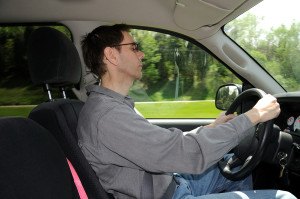

It probably happens to most drivers.
Heading home after an overtime shift and the eyelids flutter. Up all night with a sick baby and you rest your eyes for just a moment on the way to dropping off the kids at school. Drowsy drivers often make it safely to their destination, but for some, the consequences are devastating.
“To this day I still hear my boys crying out, yelling for Daddy, when they were told the news,” says Jackie Califano, the widow of a New York police officer killed when a suspected drowsy driver plowed into his parked cruiser in 2011. “The pain we experienced is beyond description and continues to be.”
 More than 11,000 deaths were attributed to drowsy driving from 2000 to 2010, according to federal statistics. And experts say it’s a problem that can’t easily be solved by new laws because proving sleepiness behind the wheel is difficult, if not impossible.
More than 11,000 deaths were attributed to drowsy driving from 2000 to 2010, according to federal statistics. And experts say it’s a problem that can’t easily be solved by new laws because proving sleepiness behind the wheel is difficult, if not impossible.
Authorities can easily determine how much alcohol is in a driver’s blood, or whether someone has used illegal drugs, or even if someone has been texting while driving.
But quantifying drowsy driving is not an exact science, prosecutors say, and laws banning commercial truck and motor coach operators from driving more than 14 hours a day and requiring 10 hours between shifts are flawed because they often rely on the drivers to report those hours themselves.
In a drowsy driving case late last year, a tour bus driver was acquitted of manslaughter and negligent homicide in a 2011 Bronx crash that killed 15 people. A jury rejected prosecutors’ arguments that Ophadell Williams was so sleep-deprived from working another job that it affected his reflexes as much as if he was intoxicated.
That verdict influenced a Long Island prosecutor’s decision this year to drop negligent homicide charges against the truck driver involved in a fatal crash that killed Califano’s husband. Ultimately, the truck driver pleaded guilty to a misdemeanor reckless driving charge and paid a $500 fine.
“If you are going to try and make fatigue – sleepiness – a criminal legal issue in a motor vehicle accident, you have a lot, lot more to prove,” said Patrick Bruno, who defended Williams in the bus crash case.
Maureen McCormick, who heads the Nassau County vehicular crimes bureau, explained that to obtain a conviction in the police officer’s death, she would have had to prove “serious blameworthiness,” “moral blameworthiness” or “dangerous speeding,” a standard she said is impossible to meet.
“Drowsy driving is something that generally has happened to everyone,” McCormick said. “The question is what do we do as a society when that feeling starts to come?”
When McCormick read a statement at the truck driver’s sentencing on behalf of Officer Michael Califano’s widow, veteran police officers and journalists wiped away tears.
“Michael, Christopher and Andrew now have to grow up without him,” McCormick said as Jackie Califano sat in the front row of the courtroom, hugging her sons, 16, 13 and 8. “No more doing homework with his help. No more sports with him. No more family vacations. No more horsing around with dad. No dad for Father/Son Night at school. No dad at home to turn to when they need advice.”
New Jersey is the only state that has successfully passed legislation addressing drowsy driving, according to Dan Brown, an Atlanta attorney and member of the National Sleep Foundation board of directors. But he noted that “Maggie’s Law” doesn’t fully solve the problem because prosecutors must show that a driver had been awake for 24 consecutive hours to prove possible recklessness, which is often a difficult proposition.
New Jersey court officials didn’t have statistics available on the number of arrests or successful prosecutions since the law was enacted in 2003.
Massachusetts state Sen. Richard Moore said he considered legislation after a constituent’s son was killed in a 2002 drowsy driving crash. But, Moore said, “It’s not as easy as drunken driving; there’s not a good deal of research.” Instead, Massachusetts is including early warning tips in driving manuals, and there is an effort to add rumble strips that warn drivers when they are drifting off the road when state highways are resurfaced, he said.
The National Highway Transportation Safety Administration says while sleep is the best cure, drinking two cups of coffee, followed by a 15-to-20-minute nap, can refresh some drivers for a short period of time. Things like turning up the radio volume, singing loudly, chewing gum or eating, and getting out of the car and running around are not effective.
“There’s not a way to legislate against sleepiness,” said Bruce Hamilton, manager of research and communications at the AAA Foundation for Traffic Safety, which instead focuses on public education campaigns and issuing brochures advising on the dangers.
Last summer, drivers in Tennessee’s four largest cities saw message boards imploring them to not drive while drowsy, along with a running tally of highway fatalities in that state.
Mark Rosekind, a National Transportation Safety Board member who formerly directed a sleep research center at Stanford University, says it’s a pervasive problem that requires a culture change to fix.
The Centers for Disease Control and Prevention released a study this year that found 4 percent of U.S. adults nodded off or fell asleep at least once while driving in the previous month.
“For some reason people in our culture think it’s OK to lose sleep and get behind the wheel,” Rosekind said. “It’s just as bad as drinking and driving. As far as public awareness, drowsy driving is in the dark ages compared to that, but it’s just as dangerous.
“The issue has been around for a while and we need to get the word out. Clearly it has not penetrated our culture.”